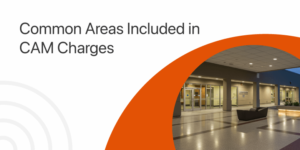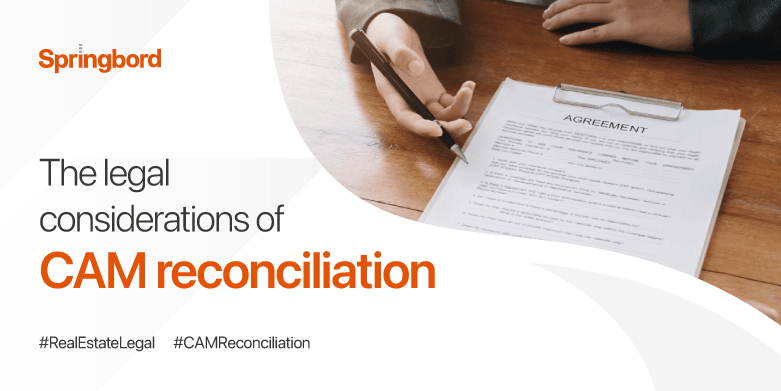 Read time 6 min
Read time 6 minAs audit season looms, managers and tenants alike in the commercial real estate world are eyeing one of the trickier items on their checklist, the common area maintenance (CAM) reconciliation. Whether you’re a landlord, property manager, or tenant, getting this process right is crucial. It’s about more than just balancing the books: it’s about transparency, accuracy, and maintaining good landlord-tenant relationships.
If you’re asking yourself, “Is our CAM reconciliation ready for audit season?”, this post walks you through what to check, what to avoid, and how to streamline the process.
For teams short on time or resources, outsourcing CAM reconciliation can be a strategic way to reduce errors, speed up the workflow, and enter audit season fully prepared.
What is CAM Reconciliation & Why It Matters
First, a quick refresher: CAM charges refer to costs associated with maintaining shared areas in a commercial property—lobbies, parking lots, landscaping, lighting, and common utilities. Even though the term and structure vary — what’s included, how it’s calculated, how it’s allocated to tenants — the principle remains the same: tenants pay a share of the costs for common areas and the landlord tracks these.
CAM reconciliation is the process of comparing the estimated/charged during the year with what was actually incurred. It reveals whether tenants owe more or have overpaid, and ensures the correct amount is passed through in line with the lease.
Why it matters:
- Accuracy & Fairness: Ensures each tenant pays their rightful share, and no one is charged for costs they shouldn’t bear.
- Budgeting & Forecasting: For tenants, knowing actual CAM charges helps them forecast costs. For landlords, reconciling helps prevent under-recoveries.
- Audit Readiness & Compliance: As audit season approaches, being able to demonstrate that the reconciliations were done properly reduces the risk of disputes.
- Trust & Relationships: Transparent reconciliation builds tenant trust; sloppy work can lead to friction.
Key Checklist Before You Jump In
Here are the pillars of a solid reconciliation process:
- Review the Lease Terms
Go back to the lease(s) and verify the fine print. What does the lease define as CAM? Are there exclusions or capped charges? How is the pro-rata share defined? Are there gross-up clauses (i.e., adjusting expenses as if occupancy is higher)?
If you don’t align your reconciliation with the lease wording, you risk misallocations or erroneous charges.
- Gather All Relevant Documentation
This means the general ledger, vendor invoices, expense records, utility bills, service contracts, occupancy data, move-in/move-out logs, and any lease amendments. Without documentation, you’ll struggle to support your numbers.
Tip: Organise documents by expense type and date to make later steps smoother.
- Verify Expense Categorisation
Not all expenses are “recoverable CAM charges”. For example, capital improvements might be treated differently or excluded. Some leases explicitly exclude certain items. Make sure every expense is coded correctly and matches the lease definitions.
- Calculate the Pro-Rata Share Correctly
Most commercial leases allocate CAM based on each tenant’s square footage versus the total, but variations abound. Also consider occupancy changes, expansions, contractions, or move-outs that may occur during the year. A tenant who moved in June doesn’t pay for January to May.
If there’s a gross-up clause, make sure the calculation uses the correct multiplier.
- Compare Estimates vs Actuals
A reconciliation should show what was estimated (and collected) during the year, what was actually incurred, and the resulting difference. If tenants paid less than the actual amount, they owe; if more, credits or reimbursements apply.
- Check for Move-Ins, Move-Outs & Changes
One of the common pitfalls: ignoring tenant occupancy changes. If a tenant leaves mid-year, you must adjust their share accordingly. If another tenant expanded, that would affect their share and possibly others.
- Verify Capped Increases, Exclusions & Lease Amendments
Some leases will cap the annual increase in CAM. Others will exclude particular services (e.g., specific capital improvements, management fees). Amendments made during the year also change responsibilities. Ensure these are integrated.
- Make the Findings Transparent and Clear
Tenant statements should clearly show actual costs, allocations, adjustments, and any balances owed or credited. Clear communication reduces confusion and disputes.

Common Mistakes to Watch Out For
Even with a good checklist, things can go wrong. Here are typical missteps and how to avoid them.
- Using outdated or incomplete lease data: If the lease was amended during the year, but you’re still using old terms, you’ll misallocate charges.
Fix: Maintain a lease-amendment log and verify lease versions. - Missing move-ins or move-outs: Ignoring changes in tenancy mid-year can skew allocations.
Fix: Cross-check occupancy spreadsheets or building records. - Mis-categorising expenses or neglecting exclusions: Charging tenants for excluded items or capital costs incorrectly.
Fix: Create a “reconciliation playbook” that lists expense categories with inclusion/exclusion rules per lease. - Incorrect gross-up calculations: If you misapply a building multiplier, tenant shares become unfair.
Fix: Document the calculation formula and validate the occupancy rates used. - Poor documentation/audit trail: When invoices aren’t available or properly tagged, the process becomes time-consuming and conflict-prone.
Fix: Digitally archive and tag supporting documents as they come in throughout the year. - Last-minute scramble: Waiting until after year-end, you find invoices delayed, staff unavailable, and occupancy data missing.
Fix: Start early, and lock in as many variables as possible ahead of time.
How to Get Audit-Ready: Practical Steps
Here is a timeline and action list to help you prepare so you’re ready by the time audit season hits.
90–60 Days Before Audit Closing
- Send reminders to vendors for outstanding invoices.
- Issue occupancy/move-in/out confirmation to tenants.
- Update lease amendments and ensure all lease records are up to date.
- Set up a reconciliation worksheet/spreadsheet with preliminary categories.
60–30 Days Before Audit Closing
- Start populating actual expenses, and compare with estimates.
- Generate draft pro-rata allocation sheets for each tenant.
- Review expense categories for potential exclusions or extraordinary items.
- Run variance analysis: large variances deserve special attention.
30–0 Days Before Audit Closing
- Finalize the tenant statements showing the actual versus the estimated amount.
- Prepare supporting documentation (invoices, contracts, occupancy logs).
- Communicate with tenants: share the draft reconciliation, offer an explanation of major variances.
- Resolve any tenant disputes or questions ahead of formal audit submission.
- Archive your entire working file and supporting documents for future audit trails.
Why It Matters From a Tenant’s Perspective
If you’re a tenant, you have just as much stake in this process as the landlord, and sometimes more. Here’s why:
- You could be overpaying. If estimates were high or expenses weren’t properly allocated, you may be owed a credit.
- You can protect yourself against unexpected charges if you understand how the CAM is calculated and reconciled.
- A clear, transparent reconciliation improves trust and the relationship with your landlord.
- By being actively involved, you can identify errors early and avoid full‐scale disputes later on.
If you suspect your CAM reconciliation isn’t transparent or you don’t receive sufficient detail, it may be time to ask questions or engage a lease audit expert.
Final Thoughts
When audit season rolls around, the question shouldn’t be “Will we reconcile CAM?” but rather “Is our CAM reconciliation ready?” By following the checklist above, aligning your process with lease terms, maintaining full documentation, and starting early, you can turn what is often a stressful task into a smooth process that instills confidence.
For property managers and landlords, the payoff is fewer disputes, more accurate budget forecasting, and stronger tenant relations. For tenants, the benefits include clarity, fairness, and protection against mischarges.
So take a moment now. Check your CAM reconciliation status, plug any gaps, and enter audit season with confidence.
Getting Audit Ready with the Right Support
When audit season approaches, it’s not just about ticking boxes; it’s about ensuring your CAM reconciliation is accurate, transparent, and defensible. By following a structured checklist, aligning your process with lease terms, maintaining strong documentation, and addressing tenant communications proactively, you can avoid last-minute scrambles and minimize disputes.
If you’re looking for a partner to streamline this process, Springbord specializes in year-end CAM reconciliation.
Our services include detailed lease-by-lease analysis, invoice review, gross-up calculations, and preparation of tenant statements, all with an eye on maximizing recoverables while maintaining clear financial records. Our approach can help you become audit-ready more efficiently, so you can focus on managing your property, rather than just reconciling it.







